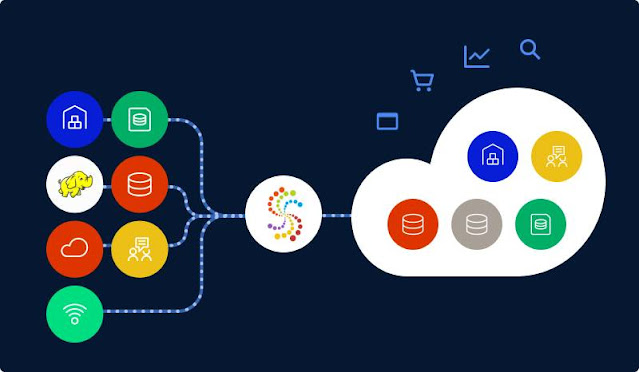Featured
- Get link
- X
- Other Apps
What are the types of data ingestion pipeline?
There are two main types of data ingestion pipelines: batch and streaming.
Batch data ingestion collects data at regular intervals and
processes it all at once. This is a good option for businesses that do not need
real-time data or can make decisions based on periodic data updates.
Streaming data ingestion collects data as it is generated
and processes it in real time. This is a good option for businesses that need
to make immediate decisions based on the latest data, such as fraud detection
or customer analytics.
In addition to these two main types, there are also hybrid
data ingestion pipelines that combine aspects of both batch and streaming
ingestion. This can be a good option for businesses that need to process both
real-time and historical data.
The type of data ingestion pipeline that is right for a
particular business will depend on its specific needs and requirements.
What are the different types of data ingestion in Azure?
Azure offers a variety of data ingestion options to meet the
needs of different businesses. Here are some of the most common types of data
ingestion in Azure:
Azure Data Factory: Azure Data Factory is a managed service
that provides a graphical user interface (GUI) and a command-line interface
(CLI) for creating and managing data pipelines. Data Factory can be used to
ingest data from a variety of sources, including cloud storage, on-premises
data sources, and third-party applications.
Azure Databricks: Azure Databricks is a unified analytics
platform that provides a managed Spark environment for data engineering, data
science, and machine learning. Databricks can be used to ingest data from a
variety of sources, including cloud storage, on-premises data sources, and
third-party applications.
Azure Stream Analytics: Azure Stream Analytics is a
real-time analytics service that can be used to process streaming data from a
variety of sources, including sensors, machines, and applications. Stream
Analytics can be used to identify patterns and anomalies in streaming data, and
to generate alerts and notifications.
Azure Event Hubs: Azure Event Hubs is a fully managed event
ingestion service that can be used to collect and store streaming data from a
variety of sources. Event Hubs can be used to ingest data from sensors,
machines, and applications, and to stream data to other Azure services, such as
Azure Data Lake Storage Gen2 and Azure Databricks.
Azure IoT Hub: Azure IoT Hub is a fully managed service that
can be used to connect, manage, and ingest data from Internet of Things (IoT)
devices. IoT Hub can be used to ingest data from a variety of IoT devices, and
to stream data to other Azure services, such as Azure Data Lake Storage Gen2
and Azure Databricks.
These are just a few of the many data ingestion options
available in Azure. The best option for a particular business will depend on
its specific needs and requirements.
The Significance of Data Ingestion in AI
Data ingestion serves as the foundation upon which AI
algorithms are built. The quality, quantity, and variety of data ingested
directly impact the performance of AI models. Properly ingested data results in
accurate predictions, meaningful insights, and informed decision-making, while
poor data ingestion can lead to biased, erroneous, or incomplete outcomes.
Whether it's training a chatbot to understand natural language, predicting
customer preferences, or diagnosing medical conditions, the effectiveness of AI
systems heavily depends on the data they ingest.
Methods of Data Ingestion
Batch Ingestion: This is the traditional method where data
is collected, stored, and processed in fixed batches. It involves storing data
over a period and then processing it at once. Batch ingestion is suitable for
scenarios where real-time processing is not necessary, such as historical
analysis or training models offline.
Stream Ingestion: In this method, data is ingested in
real-time as it is generated. Stream ingestion is crucial for applications that
demand instant responses, like fraud detection, social media sentiment
analysis, and monitoring industrial equipment for anomalies.
Change Data Capture (CDC): CDC involves capturing only the
changes made to a database, reducing the amount of data transferred. It's a
blend of batch and stream ingestion, often used when continuous updates need to
be integrated without duplicating entire datasets.
Federated Learning: This decentralized approach involves
training AI models across multiple devices or servers while keeping the data
localized. The model's collective knowledge is then used to improve itself.
Federated learning is particularly useful when data privacy concerns arise.
Future Trends and Innovations
The field of data ingestion for AI is continually evolving,
driven by technological advancements and industry demands. Some future trends
and innovations include:
Automated Data Preparation: AI-powered tools will streamline
data preparation tasks such as cleaning, transformation, and integration,
reducing the manual effort required.
Edge Computing: Ingesting data directly at the edge devices
(Internet of Things devices, sensors, etc.) before sending it to central
servers will reduce latency and save bandwidth.
Unstructured Data Handling: AI systems will become more
adept at ingesting and making sense of unstructured data like images, videos,
and text from various sources.
AI-Powered Ingestion: AI algorithms themselves will play a
role in data ingestion by making decisions about what data to ingest based on
their learning objectives.
- Get link
- X
- Other Apps
Popular Posts
The Intersection of Health Sciences and Geography - Reading Answers for IELTS
- Get link
- X
- Other Apps



Comments
Post a Comment